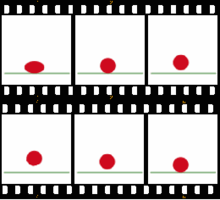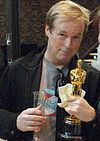Portal:Animation

| Main | Categories and topics | Tasks and projects |
Introduction
Animation is a filmmaking technique by which still images are manipulated to create moving images. In traditional animation, images are drawn or painted by hand on transparent celluloid sheets (cels) to be photographed and exhibited on film. Animation has been recognized as an artistic medium, specifically within the entertainment industry. Many animations are computer animations made with computer-generated imagery (CGI). Stop motion animation, in particular claymation, has continued to exist alongside these other forms.
Animation is contrasted with live-action film, although the two do not exist in isolation. Many moviemakers have produced films that are a hybrid of the two. As CGI increasingly approximates photographic imagery, filmmakers can easily composite 3D animations into their film rather than using practical effects for showy visual effects (VFX). (Full article...)
Selected article
The animated television series Rugrats has been noted for its portrayal of Judaism, a dynamic rarely portrayed in American animated programming during the series' broadcast run (1991–2004). Two episodes of the series are devoted to Jewish holidays and explaining their history, and the Pickles family is shown to be part-Jewish. The first Rugrats Jewish holiday special was suggested to the production staff in 1992 by Nickelodeon executives as a special devoted to Hanukkah. Germain instead refashioned it into a Passover episode and the series did not explore a Hanukkah special until 1996. Critical reaction to Jewish themes in Rugrats was largely positive. Each holiday special achieved high viewing numbers according to Nielsen Media Research and received positive reviews. However, Jewish character Grandpa Boris' portrayal in a 1998 Rugrats comic strip was criticized by the Anti-Defamation League for apparent antisemitism.
Selected image
Did you know (auto-generated) -

- ... that according to an elaborate 1990s joke, Elmo Aardvark was history's first animated cartoon character?
- ... that the Pakistani film Shehr e Tabassum was the first animated cyberpunk film to be made by an Urdu development team?
- ... that the French animated film The Summit of the Gods is based on a Japanese manga series?
- ... that, for the animated film Us Again, director and writer Zach Parrish considered a video of an elderly couple dancing to be visceral and ideal inspiration?
- ... that the Tuca & Bertie episode "The Jelly Lakes" employs a paper-cutout animation that helps to depict abuse in a way that centers the victim's story?
- ... that the 1937 Fleischer Studios strike in New York City was the first major labor strike in the animation industry?
Selected quote
Selected biography
Matthew Richard "Matt" Stone (born May 26, 1971) is an American screenwriter, producer, voice artist, musician and actor, best known for being the co-creator of South Park along with creative partner and best friend, Trey Parker. Stone and Parker launched their largely collaborative careers in 1992, making a holiday short titled Jesus vs. Frosty. Their first success came from Alferd Packer: The Musical, subsequently distributed as Cannibal! The Musical. From there he made another short title Jesus vs. Santa, leading him and his college friend Trey Parker to create the animated television series South Park, which has been on television for over a decade. He has four Emmy Awards for his role in South Park, winning for both "Outstanding Programming More Than One Hour" and "Outstanding Programming Less Than One Hour".
Selected list
The accolades received by Ratatouille, a computer-animated film produced by Pixar and distributed by Walt Disney Pictures. The film was released on June 29, 2007 in the United States as the eighth film produced by Pixar. It was directed by Brad Bird, who took over from Jan Pinkava in 2005. The plot follows Remy, a rat who dreams of becoming a cook chef and tries to achieve his goal by forming an alliance with a Parisian restaurant's garbage boy. Ratatouille was released to both critical acclaim and box office success, opening in 3,940 theaters domestically and debuting at #1 with $47 million, grossing $206,445,654 in North America and a total of $624,445,654 worldwide. The film is on the 2007 top ten lists of multiple critics, including Michael Sragow of The Baltimore Sun as number one, A.O. Scott of The New York Times, Carina Chocano of the Los Angeles Times and Joe Morgenstern of The Wall Street Journal as number two. It was nominated for five Academy Awards, including Original Score, Achievement in Sound Editing, Achievement in Sound Mixing, Original Screenplay and Animated Feature Film, winning the latter one. Ratatouille was nominated for 13 Annie Awards, twice for the Best Animated Effects, where it lost to Surf's Up, and three times in the Best Voice Acting in an Animated Feature Production for Janeane Garofalo, Ian Holm and Patton Oswalt, where Ian Holm won the nomination. It won the Best Animated Feature Award from multiple associations including the Chicago Film Critics, the National Board of Review, the Annie Awards, the Broadcast Film Critics, the British Academy of Film and Television (BAFTA) and the Golden Globes.
More did you know...
- ...that Jeremy Irons (pictured) guest-starred in The Simpsons episode "Moe Goes from Rags to Riches" as the voice of a bar rag?
- ...that U.S.-based television production company Zodiac Entertainment intentionally avoided references to American culture in its shows?
- ...that Tissa David, the second woman to direct an animated feature film, also animated the Raggedy Ann character for the 1977 film, Raggedy Ann & Andy: A Musical Adventure?
Anniversaries for May 13
- Films released
- 1933 - Wake Up the Gypsy in Me (United States)
- 1939 - Kristopher Kolumbus Jr. (United States)
- 1965 - Pinkfinger (United States)
- 1965 - Shocking Pink (United States)
- Television series and specials
- 2006 - Justice League Unlimited, an American animated series based on the DC Comics superhero Justice League finishes airing on Cartoon Network
- 2006 - Xiaolin Showdown, an American animated television series finishes airing on Kids' WB
Subportals
Related portals
Wikimedia
The following Wikimedia Foundation sister projects provide more on this subject:
-
Commons
Free media repository -
Wikibooks
Free textbooks and manuals -
Wikidata
Free knowledge base -
Wikinews
Free-content news -
Wikiquote
Collection of quotations -
Wikisource
Free-content library -
Wikiversity
Free learning tools -
Wiktionary
Dictionary and thesaurus

























